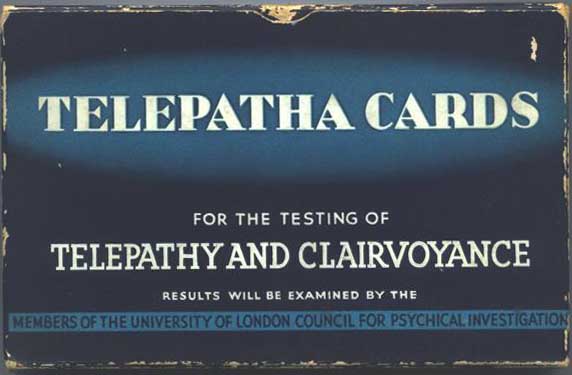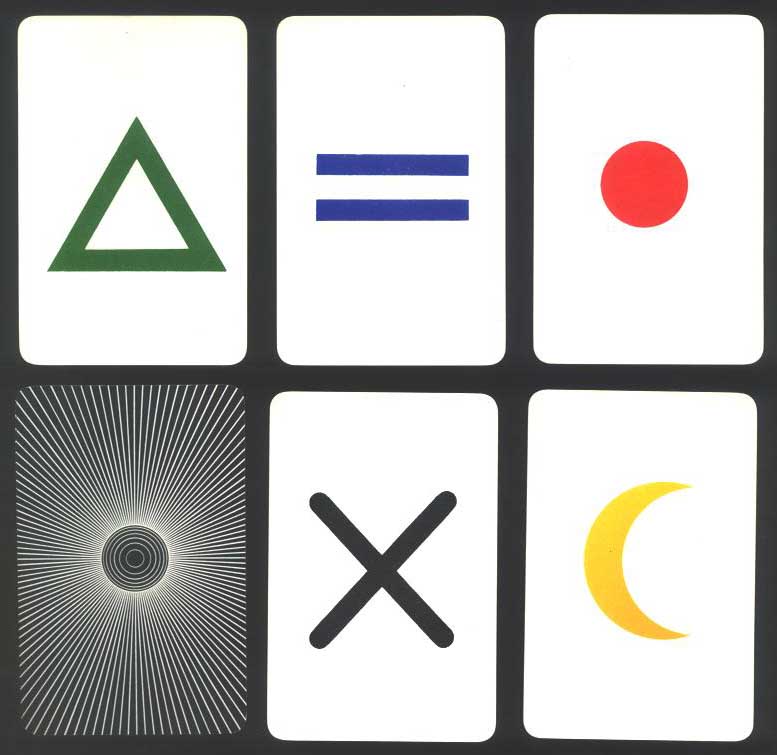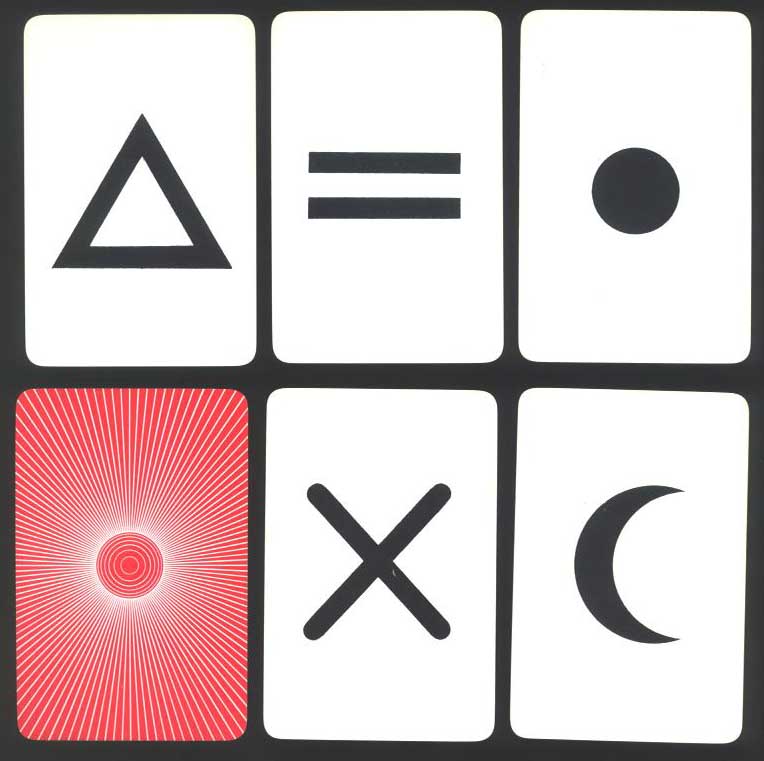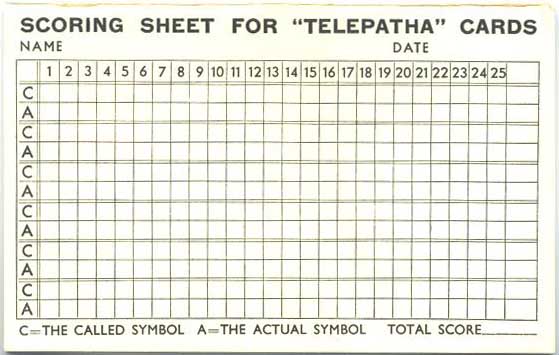|
The National Lab. of
Psychical Research & The University of London Council for Psychical
Investigation |
|||||||||||||
|
|
In 1937, the Department of Psychology headed by Dr. J.B. Rhine at Duke University in America issued an official set of Zener cards for the testing of extra-sensory perception. Later a commercial set with instructions for use was produced and when Harry Price received a set he found that because of the particular design which had been used on the reverse it was possible for someone being tested for E.S.P. to recognise some of the symbols on the cards from their backs. Price decided to produce his own set of cards which could not be read easily in this way and the backs of which were the same whichever way up the cards were held. The result was his 'Telepatha cards' which were made by Messrs. Waddington & subsequently marketed by Messrs. George Newnes Ltd of London. The cards had the standard Zener symbols (rectangle, star, plus sign, circle & wavy lines) on their faces while the reverse side had an impenetrable 'dazzle' design. The slim box for these cards also contained a set of printed instructions & a score sheet. The following is an extract from Chapter X (The Story of E.S.P.) of Price's Fifty Years of Psychical Research (Longmans, Green & Co., 1939) in which Price describes his development of the Telepatha Cards. I have replaced the illustration which was included in Price's book to which he refers with scans of my own set of cards together with the box and score sheet. The Instructions for Using "Telepatha Cards" are also included on a separate page. THE ZENER CARDS The early E.S.P. cards as used by Rhine and his colleagues at Duke were originally hand-made. As even playing-cards when made commercially are never mechanically perfect, it is obvious that the early home-made ones were unsuitable for critical work. The first commercially printed E.S.P. cards were, I think, those which I had made for me by Messrs. Plafair of London in November, 1934, for the Soal experiments in the laboratory of the University of London Council for Psychical Investigation, and which are still in use. They have on their faces the Zener symbols: rectangle, star, plus sign, circle, and wavy lines. The backs are of a uniform 'playing-card' design.
In 1937 the official Duke University Zener cards were put on the American market. They were of two kinds, plain and coloured symbols. The backs of both kinds were similar in design, but different in colour (blue and brown respectively). These cards, complete with instructions, were issued commercially and could be purchased at any news stand at 10 cents per pack. Later, a boxed 'set' of two packs of cards, instruction book, (1) and scoring pad, were offered to the public for $1.75 complete. When I received a pack of the commercial E.S.P. 'official' cards I had a shock. I found that through employing an unsuitable design on the reverse of the cards, the stamping die had so cut the pattern (lines and circles) that some of the cards could be recognized from the backs. In other words, parts of the pattern varied on some cards. I found that, in five minutes, I could recognize ten of the cards from the backs, just as Dr. Britt demonstrated in New York. Another fault with these cards is that the pattern is not a symmetrical one (i.e. uniform either end) on account of the photograph and lettering in the centre. This lends itself to manipulation on the part of unscrupulous subjects. (2) The outcry against being able to read the Duke cards from the backs was met by Rhine advising experimenters to cover them over with something when being used - a vital precaution that Soal had been taking with my Plafair cards in every experiment he had ever made. But in the directions sold with the Duke cards, or in the Stuart and Pratt handbook (3) issued with them, not a word of warning is given about screening the backs of the cards when testing for E.S.P. On the contrary, on page 12 of the handbook(3) permission is given to look at the backs: 'Sit where you cannot see the faces of the cards. You may close your eyes or look off into space, or even look at the backs of the cards.' (4) It is obvious that some results obtained with these unscreened cards may be valueless. To my knowledge, neither cards nor handbook have yet been withdrawn. In fact there is a sort of defence of the cards in the Journal of Parapsychology, (5) of which Professor McDougall (6) and Dr. Rhine are editors. (7) Under the heading 'ESP Card Imperfections' it is stated that 'since it is much easier to set up simple experimental precautions than to attempt to produce a "perfect" commercial ESP card, it is doubtful whether improvements are at present feasible.' A NATIONAL TEST When I read the above curious statement, I determined to produce a card which could not easily be read from the back except by a hyperæsthete, and the back of which was the same whichever way one held it. The result is illustrated on page 186. I named them the 'Telepatha' cards, and they are made by Messrs. Waddington and marketed by Messrs. George Newnes, Ltd., London. The pattern of the backs was specially designed to dazzle the eyes of any subject who attempted to obtain visual clues or indicia from the backs of the cards. The symbols on the faces of the cards are X-sign, = sign, triangle, spot, and crescent. The 'Telepatha' card set comprises two packs each of twenty-five cards, with both plain and coloured symbols, an instruction book, and scoring pad.
In an article in John o' London's Weekly, (8) I suggested that a national test should be held in Great Britain in an effort to ascertain if good telepathic subjects could be found in this country. Mr. Frank Whitaker, the editor of John o' London's Weekly, thought well of the idea and in the next issues of his journal, a great national competition was launched. Professor J. C. Flugel, (9) Mr. S. G. Soal, (10) and I were asked to supervise the arrangements, my 'Telepatha' cards being chosen for the tests. The most stringent laboratory conditions were imposed on the competitors. The competition is in full swing as I write these lines. (11) To the uninitiated, testing subjects for E.S.P. may sound a simple job; in reality it is a most difficult and complicated one. To be an efficient experimenter, one should be a conjurer, psychologist, and mathematician rolled into one. The pitfalls are many. To begin with, there may be collusion between experimenter and subject. Or the latter may be able to exchange his own prepared pack ('stacked' cards) for those of the person testing, or see the reflection of card faces in mirror, pictures, or shiny table-top. Codes, visual or aural, might be used between the subject and any person in the room able to see either backs or faces of the cards. Marked, dirty, stained, cracked, or used cards would provide the subject with clues, if they were not screened. Bad shuffling of cards on the part of the tester would increase the 'good' guesses if the subject - consciously or unconsciously - remembered their order. In addition, there is always the possibility of experimental error, faulty recording, mal-observation, faked records, or sheer lying on the part of the experimenter or his assistants. Mr. S. G. Soal, in an illuminating address to the Ghost Club (12) on March 15, 1938, related many of the snags in E.S.P. work. He pointed out that even in the most perfect commercial cards there is always some small speck or irregularity, made either mechanically or in printing, visible to good normal eyesight. And many more markings, etc., would be visible to a person like Marion, whose feats due to hyperæsthesia of the various senses (especially that of touch) have to be seen to be believed. (13) A person has only to see or recognize one card in a pack of twenty-five to send up his average from a chance score of five to an extra-chance score of six. Marion was able to pick out in the light a card that he had never seen, but had touched only once in the dark.
Another source of error is the careless handling of a pack of cards so that the subject sees the bottom one. There again his average would rise to six. It is also possible for a perfectly honest experimenter, by unconscious whispering, slight bodily movements, change in breathing rate, or other indicia, unconsciously to convey to the equally honest subject when a card is called correctly. The subject might then be aware, subconsciously, when five of one symbol (the full set) had been called, and would refrain - also sub-consciously - from calling that symbol again. This would send up his average score above chance. That is why a screen between experimenter and subject is necessary. Preferential mental associations (and 'pattern habits') must also be taken into account. All these 'snags' and many others are detailed in Mr. Soal's paper, (14) which should be read by those wishing to conduct experiments in E.S.P. Before I conclude this story of E.S.P. and its recent dramatic developments, I must reiterate that the successes of Dr. Rhine and his colleagues at Duke University have not yet been accepted by official science in any country. Dr. Rhine himself has published two highly provocative works in which he claims to have demonstrated scientifically that clairvoyance and telepathy are faculties possessed by many people in America. All that is now needed to complete the trilogy is a volume telling us how we can reproduce the Duke 'miracles' on this side of the Atlantic.
|
||||||||||||
The Base Room . Biography . Timeline . Gallery . Profiles . Séance Room . Famous Cases . Borley Rectory . Books By Price . Writings By Price . Books About Price . Bibliography . Links . Subscribe . About This Site All original text, photographs & graphics used throughout this website are © copyright 2004-2005 by Paul G. Adams. All other material reproduced here is the copyright of the respective authors. |




